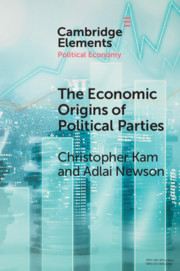Element contents
The Economic Origin of Political Parties
Published online by Cambridge University Press: 08 January 2021
Summary
- Type
- Element
- Information
- Series: Elements in Political EconomyOnline ISBN: 9781108908726Publisher: Cambridge University PressPrint publication: 07 January 2021
Bibliography
- 7
- Cited by



